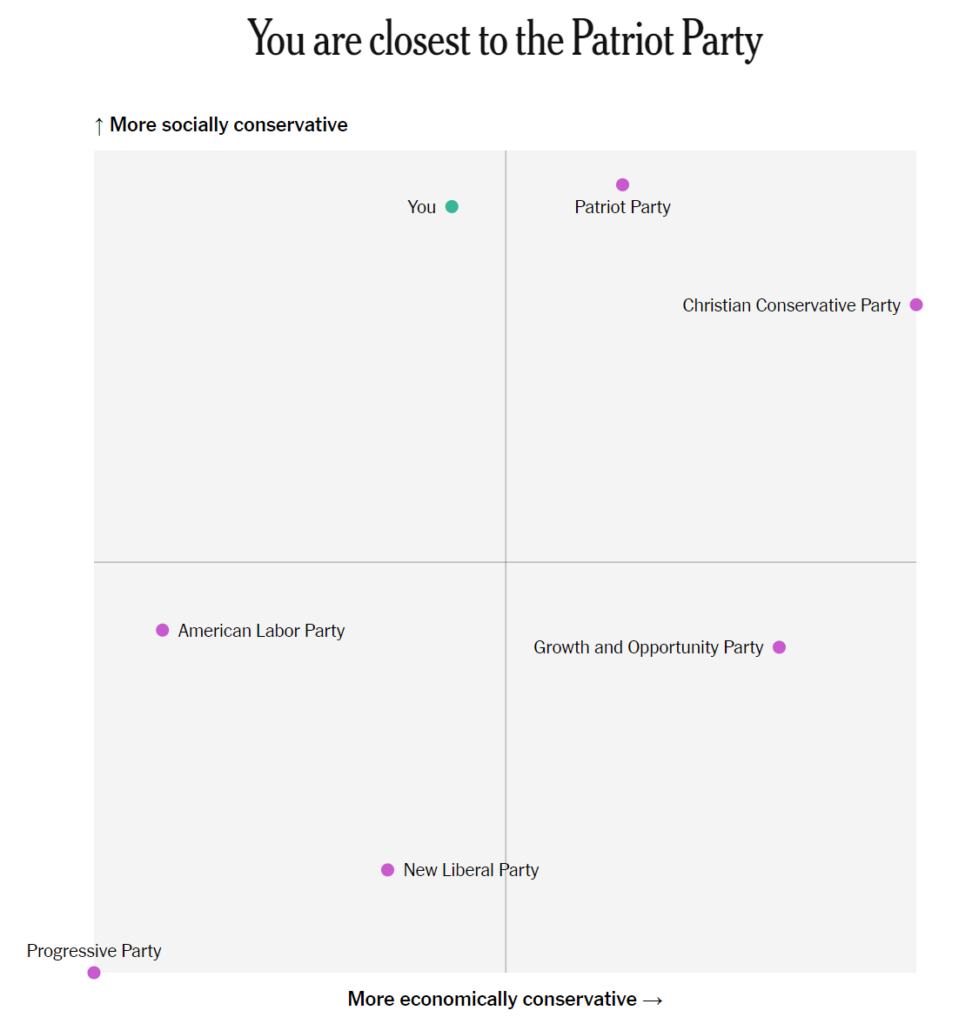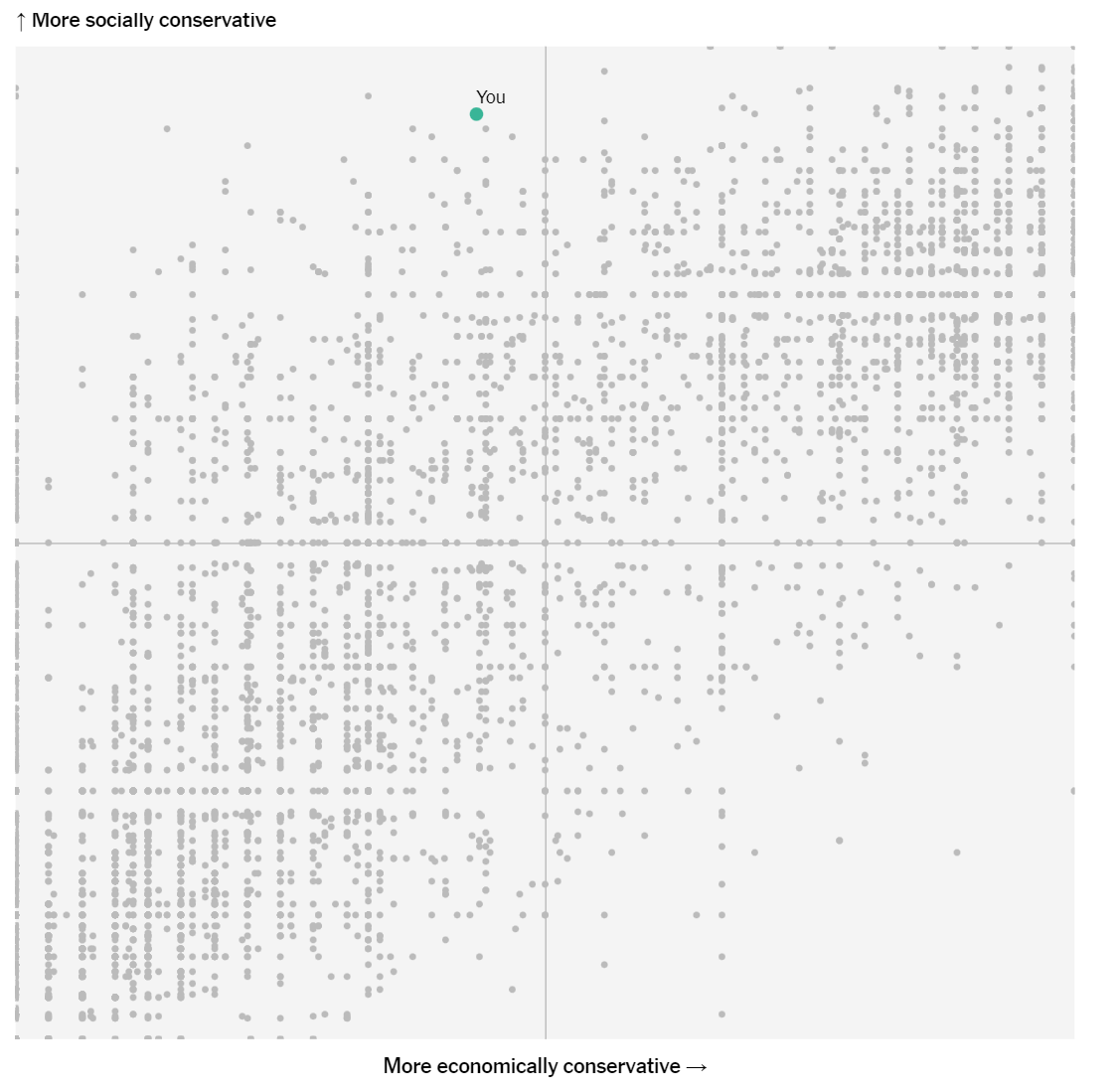NYT Examines the Political Compass...kinda

I was pleasantly surprised to see Ross Douthat tweet his results on what looked like a variation of the political compass earlier today. Not because his results were unexpected (I’m in a similar position only slightly more socially conservative), but rather because the New York Times seemed to be acknowledging the failures of our typical two-party system and a binary “left-right” split in all things political. I have written about the faultiness of the original political compass test, so I was equally pleased to see that the Grey Lady had substituted the former test and its questions for their own, slightly tweaked methodology. This chart substitutes the lackluster “authoritarian-libertarian” axis for the superior “conservative-progressive” axis, and there are no questions asking about my belief in astrology or whether the enemy of my enemy is indeed my friend. While there is only a sample of 20 questions, they are all actually focused on political beliefs! Imagine that.
There’s not much to say about the questions themselves, as they are rather basic and fit inside the current Overton Window of typical American discourse. Questions about abortion, gun laws, whether you believe in systemic racism, and a few on regulation and increasing taxes for the economic portion make this test passable if limited in its nuance. I did answer “neutral” to a few economic questions as I felt they were rather vague or that I didn’t lean absolutely in one direction or the other (for example, I’m in favor of reducing red tape for small businesses and entrepreneurs, but also for heavily regulating larger corporations more than they currently are). If you want to try the test for yourself, it is located here (if you don’t have a Times subscription like I don’t, opening in an Incognito or otherwise private window should get around the paywall if it pops up). However, the author Lee Drutman attempts to go a step further and break these results into six broad categories, imagining the United States if it had a multi-party system with multimember districts. Election theories aren’t my strong suit, so here I’ll let those curious learn from CGP Grey about alternatives to the current U.S. one-member winner-takes-all first-past-the-post election system. Drutman splits up the generalities of the current Democratic and Republican coalitions into six main new parties and attempts to place them on this new chart.
And this is where his efforts fall flat. Or in the least, he lacks imagination.
As you can see at the end of the test (or in the image at the top of this blog), the six new parties are as follows: the Patriot Party, the economically “populist” and socially conservative group dominated by folks like Donald Trump, Josh Hawley, and Tucker Carlson (which I and Douthat are the closest to); the Christian Conservative Party, which is slightly less conservative(?) and much more economically right-wing, voting for folks like Mike Pence and Nikki Haley; the “socially moderate, pro-business” Growth and Opportunity Party, led by folks like Mitt Romney (yikes), John Kasich (double yikes), and Michael Bloomberg (WTAF); the New Liberal Party, which are the establishment neoliberals in the Democratic Party such as Pete Buttigieg, Cory Booker, and Robert ‘Beto’ O’Rourke; the socially moderate, left wing American Labor Party that focuses on the working-class wing of the current Democrats (led by three people I’ve never heard of before, go figure); and finally, in the bottom left corner, there is the Progressive Party, socially woke and leftist on economics, led by people like AOC and Elizabeth Warren.
There are a few issues with these six parties, or what they’re missing to be exact. I mostly chalk that up to the author living in the New York Times’ bubble and focusing exclusively on the coalitions within the current parties as if they were just distinct factions. With the Christian Conservatives as the exception, I don’t see much to change about the parties as they exist. I think the Christian Conservatives would likely be slightly more, you know, conservative on social issues and likely more moderate on economic issues (instead moving the Growth and Opportunity party, the so-called “pro-business” group, further towards the economic right instead). The biggest disappointment, I suppose, is that there isn’t a single party in the upper left quadrant. There are two in the “economic right, socially conservative” quadrant, three spread across the “economic left, socially progressive” quadrant, and there’s the libertarian Growth and Opportunity Party in the “socially liberal, fiscally conservative” area all alone. I know that there’s a lot that would need to happen for multiple parties to actually exist in America, but is there any good reason there wouldn’t be a “socially conservative, fiscally left” party?

Now, I could just be miffed because I (and Ross Douthat) are the two unique individuals in that quadrant and are politically homeless even in an expanded American electorate. Except that Drutman’s analysis also includes survey results from 5,000 voters in a Democracy Fund poll, placing them on the same grid to show where American voters really fall when given more than an R or a D to bubble in on a ballot. There are several answerers that are clustered on the direct edges of the map, suggesting that the Overton Window is too small for a proportion of American Voters who would otherwise be even further left, right, conservative, or progressive than the test allows. But more than that, there is easily a quarter of all answerers falling in that fated Upper Left Quadrant, where notably ZERO new political parties fall. There are more voters in this quadrant than even the opposite “libertarian” quadrant, where the “Growth and Opportunity Party” would theoretically fall. The best option for these voters? Either compromise slightly on economics for the Patriot Party (move further right fiscally) or compromise significantly on social values to join the American Labor Party (move further down, i.e. progressive, socially).
Now the results of the survey itself did not fully shock me. It seems similar to another analysis Drutman performed on the 2016 electorate, polling American voters that November on a host of political issues and then plotting on a similar graph, color coded by which major candidate that individual voted for (Clinton, Trump, or “Other”). As you can see in that graph (full analysis here), while Clinton dominated the fiscally- and socially-leftwing portion of the electorate, Trump voters were a mixed bag of centrist-to-socially-conservative voters, many of whom were admittedly left-of-center on economics. So while the “socially conservative but not free market fundamentalists” might be politically homeless in our current two-party system, and while a GOP that was smarter would move closer to the center economically and hammer home social issues to secure voters, it doesn’t seem like this group is insignificantly small.

In fact, there is a current option for such voters who are dissatisfied with the Republicans miserly economic policy and subsequently turned off by the woke craziness domineering the Democrats: the American Solidarity Party. Fashioned in the mold of Christian Democracy parties in Europe and basing many of their policy points on Catholic Social Teaching and G.K. Chesterton’s economic Distributism theory, the American Solidarity Party is probably the closest thing to a “socially conservative, fiscally liberal” party that’s actually growing in the United States (though the ASP would be the first to reject such labels as overly simplistic). Certainly, there are positions the ASP advocates for that exist outside the typical left-right paradigm, such as repealing no-fault divorce laws to promote permanence in marriage, allowing proportional representation and ranked-choice voting (again, CGP Grey), and discouraging the use of technology in the classroom for young children.
While I’m holding out hope for the GOP to evolve closer to where I sit (existing laws and infrastructure naturally favoring establishment parties to shift on issues than new parties finding success), I will admit I voted for Brian Carroll in the 2020 election for President. And if enough of the Upper Left Quadrant voters choose to protest the two major parties, then who knows? Maybe we’ll get considerable movement towards our ideals in national politics, maybe more minor parties are able to break into the national discussion, and if we’re lucky, the New York Times might stop ignoring our existence.